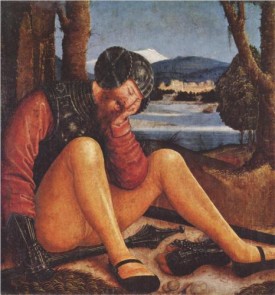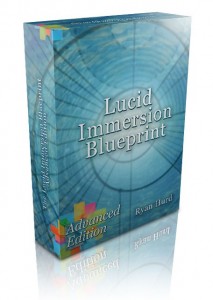
A few years ago, I took a flight from Atlanta back to my home in San Francisco. I was sleep deprived after a late night out with old friends. The afternoon I arrived home, I drove down to Ocean Beach and took a nap in the car, leaving the window open for the ocean breeze. My seat was reclined most of the way and I fell asleep on my back. I instantly slipped into sleep paralysis.
The feeling of sleep paralysis is like being stuck in the threshold between sleep and wakefulness, and can trigger intense fear if you have never experienced it before. However, you can easily learn how to shift from sleep paralysis into a lucid dream or an OBE, especially by zapping negative expectation with an affirmation or a gratitude practices. After 20+ years of this peculiar altered state, I knew the drill.
I kicked myself out of my perceptual body and began drifting down a dark river.
It was dark and quiet. The air was noticeably cool.
I relaxed, looking at the lights of stars overhead. I woke myself up by wriggling my little toe, and feeling refreshed, spacious and focused.
This nap vision didn’t occur randomly. I was primed for some weird REM sleep effects because I was sleep deprived. But it was the posture of laying on my back, and slightly inclined, that brought me to the threshold.
Posture not only can increase the likelihood of out-of-body experiences, but it can bring on some rich lucid dreams too, particularly wake-initiated lucid dreams (WILD) in which you fall asleep and maintain awareness. I have personally had excellent results with WILDs when my head and upper torso are comfortably propped up in bed.
Why does a slight incline work?
In short, it appears to increase mental vigilance compared to laying completely flat.

We know from historical sources that we are more likely to awaken if propped up rather than fully prone.
For example, a common practice for soldiers in the 19th century American frontier included round-the-clock guard duty. Soldiers on duty slept on an inclined wooden bench, with their musket close at hand, a practice called “sleeping in the leather.”1
A group of Buddhist monks in Scotland used this practice to an extreme: sleeping completely upright in a box for less than five hours at a time.
Ani Lhamo, secretary to the abbot at the Samye Ling monastery, was quoted as saying, “If you are more upright when you sleep, when you wake up you haven’t slept so deeply, and it is easy to wake up quickly and get going.”
Indeed, Tibetan Buddhists have practiced secret sleeping postures for hundreds of years. Buddhist lama Tenzin Wangyal Rinpoche suggests that “using a high pillow will help keep sleep light and generate more lucidity in dreams.”2
Another practice in Buddhist dream yoga involves reclining on a stack of pillows and sitting cross-legged. After a period of counting breaths, you fall asleep and dream. Tellingly, this particular practice is recommended for early morning, about four hours into the sleep period, when arousal rates naturally hiccup.
The call for night vigilance can also be seen in the historic European tradition of the night watch, the time of contemplative wakefulness in between first and second sleep.3
Most clinical research about sleeping supine (on your back) versus prone (sleeping on your stomach) has been conducted with infants in the search for the cause of Sudden Infant Death Syndrome. The infant is safer sleeping on his back, especially in the first three months of life. Privy to this conversation: infants who sleep on their backs have greater cortical arousal, and more awakenings, during REM sleep.
Put it to use tonight
For out-of-body experiences, position yourself semi-elevated and then try these recommended exercises.
For lucid dreaming. try combining a slightly elevated posture with a wake-back-to-bed method (WBTB) in the middle of the night. WBTB is about rousing (by alarm) for a short period of nighttime wakefulness in the very early morning.
Spend your time reading, journaling, or meditating, as all three of these activities are simultaneously relaxing and known to increase cortical arousal.
A warning: don’t substitute video games or computer work for your middle-of-the-night vigilance, as light in the blue spectrum may stall melatonin production and can make it hard to get back to sleep at all. If you look at monitors at night, I recommend warming up the color spectrum. Here’s a great free program called f.lux that does this automatically. (I’m using it right now in fact).
Also, make sure you are staying safe and are securely positioned on your mattress or comfortable surface. Falling asleep standing up can be dangerous because you completely lose muscle tone in REM sleep.
Combining the mental agitation with the natural increase of the relaxation-inducing hormone known as prolactin in the middle of the night4 is the perfect recipe for peaceful clarity. And that’s the basic secret to wake-initiated lucid dreams in general: blend positive stress with relaxation, close your eyes, and let the great show begin.
 Try it tonight and let me know how it goes!
Try it tonight and let me know how it goes!
This article is adapted from the Lucid Immersion Blueprint.
Additional sources
1. Moore, R. and Haynes, M. (2003). Lewis and Clark: Tailor made, trail worn. Helena, MT: Far Country Press, p. 33
2. Wangyal, T. (1998). The Tibetan yogas of dream and sleep. Ithica, NY: Snow Lion Publications, p. 109.
3. Naiman, R. (2006). Healing night: the science and spirit of sleeping, dreaming and awakening. Minneapolis: Syrene, p. 90.
4. Wehr, T. (1999). The impact of changes in night length (scotoperiod) on human sleep. In F.W. Turek and P.C. Zee (Eds.), Neurobiology of sleep and circadian rhythms, (pp. 263– 85). New York: Marcel Dekker.
First Image: Sleeping Lion (CC, 2009) by Rennett Stowe
You mentioned that this worked for you a few years ago in the introduction. Have you been playing with this method recently and had success?
Hey Chris,
I haven’t needed to try this method recently because I’m getting quite enough lucid dreams and sleep paralysis due to my polyphasic lifestyle (read: I have an infant and sleep when I can). It’s a winner though, it reliably increases the length of my hypnagogia too.
Thanks for the article Ryan, I appreciate this.
let me know when you have some more WILD success!
Ryan, I slept like this last night completely unrelated to your post–it just happened naturally. I’m recovering from a cold and had a coughing fit, so I propped myself up with two pillows so I could breathe easier. I quickly fell back asleep and then had a rare instance of sleep paralysis. It was scary so I got mad and yelled. That, of course, woke me up. So no lucid experiments, but I can confirm that for me, at least, this does work.
creepy! and yeah, it works. 🙂
Reading your post, i wanted to comment that when ever i sleep somewhere other than my own bed I’m quite successful at lucid dreaming and being able to keep myself there by the hand rubbing trick. it’s the smell, the sounds, the position, there all relative. your brain wants to keep you more aware, unsure of where it’s at and keep you in a lighter sleep state even when in rem
yes! good point. I wrote an article about traveling and this lucid vigilance effect here: http://dreamstudies.org/2012/10/10/stir-it-up-lucid-dreaming-traveling-and-the-vigilance-effect/
Thanks for that program link along with the article. I must admit it worked a lot better than I originally thought it would. With school I usually find myself on the computer late at night and then have troubles getting to sleep, my eyes felt a relief almost instantly.
I also noticed instant relief from eye strain when I installed f.lux.
Thank you for the article Ryan. By the way, I didn’t know that prolactin may be a relaxation-inducing factor at nignt! Very interesting info.
thanks! I heartily recommend Rubin Naiman’s book Healing night (from where I got that factoid) for more fascinating and useful information about sleep and wholeness.
Physiological symptoms of sleep paralysis are the same with those of syncope. Thus, sleep paralysis is caused by syncope. For experts in cardiovascular diseases, sleep paralysis or syncope is a common symptoms of cardiovascular disease?1?. For a long time, due to the ignorance of physiological knowledge of syncope , ischemie cerebrale ,palpitations and so on, psychological illusion in people’s sleep generated by such physical symptoms i.e. the nightmare really has puzzled the psychologists, therefore they put forward a wide range of wrong even absurd views on the nightmares, which both have no scientific basis, and could not be confirmed, even more were not self-consistent. For example, a medical expert Debacke drew the correct conclusion that the anxiety-dream resulted from ischemie cerebrale according to the physiological symptoms of the anxiety-dream of a boy of thirteen. Freud called such view was a ” medical mythology” in the book of Dream Psychology. Most important,the experiment confirmed the idea. For example, a place in country , there is a “haunted” bed which makes people have sleep paralysis or syncope every night, and it is this fact that the pillow in the bed is too high will reduce cerebral blood flow. ?1? http://www.medhelp.org/posts/Sleep-Disorders/Nocturnal-fainting/show/11612